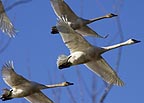January 11, 2006
SIUC researchers study habits of trumpeter swans
CARBONDALE, Ill. -- With a startled, soft honking and the tips of their gigantic snow-white wings slapping the surface of the water, the flight of seven trumpeter swans sprinted across the surface of the pond before gradually lifting into the chilly blue Southern Illinois sky.
Researchers from Southern Illinois University Carbondale are shadowing the birds as they settle in once again at their winter home on a reclaimed coal mine north of Carbondale that is teeming with wildlife of all sorts.
Dana Varner, a graduate student at SIUC, visits this former surface mining operation often, recording every move the great birds make. As of mid-December, about 100 of the surprisingly large animals were wintering at Burning Star No. 5, located on 8,400 acres of rolling tall grass, farm fields, woods and ponds owned by Consolidated Coal Co., just east of De Soto.
A few trumpeters began visiting this Southern Illinois respite during the mid-1990s. Their numbers have grown each year since; a fact that intrigued SIUC's Michael W. Eichholz, who is supervising Varner as she pursues her master's thesis.
Eichholz, assistant professor of zoology, studied the trumpeters' slow recovery from the edge of extinction at the early part of the last century to their more recent recovery, thanks to captive breeding and reintroduction to the wild.
Several groups of birds making up the Midwest or "interior" population now exist. But few have re-established traditional migratory patterns, choosing instead to stay put in upper Midwestern states including Michigan, where well-meaning people keep the birds well fed. Another potential issue perhaps discouraging the birds' migration is the reduction of their normal wetland feeding grounds, which provided an abundance of their traditional underwater plant diet.
Eichholz wants to know if the migrating birds are as healthy and productive as the non-migrating population. He also wonders to what extent the trumpeter swan, like other similar species, has learned to incorporate farm waste grains into their diet in place of the less-available underwater vegetation. To do that, he will compare those wintering near De Soto, which eat such waste grains, with a group living on the Mississippi River near Alton.
Eichholz recently received $117,000 from the Illinois Department of Natural Resources for his study. He and Varner are working with state biologists in Wisconsin – where these birds nest and breed – to study how well the migrating population is living.
The goal is to provide good management information to the IDNR and other groups that will encourage the re-establishment of a strong, self-sustaining trumpeter swan population in the Midwest. Burning Star No. 5 provides a perfect laboratory to answer those questions.
"They are beautiful birds and they were hunted almost out of existence," said Eichholz, who grew up in Southern Illinois and specializes in migratory birds. "This area at the mine provides a couple of things they need open water and agricultural habitat with little disturbance."
The birds are impressive, if for nothing else, their sheer size. Wingspans can surpass 7 feet and a full-grown swan stands 4 feet tall on the ground. Larger males, called cobs, can reach 35 pounds, though most fall in the 20-30-pound range. They live for 20 to 30 years and mate for life.
And of course there is the distinctive call for which they are named; a soft, horn-like cry they emit while rowing through the air in a characteristic "V" pattern. Watching one set its wings and glide onto the water's surface can't help but conjure images of a seaplane skimming its way to a landing.
At one point more than 100,000 trumpeter swans made up the interior population. Commercial hunters, however, prized the birds for their sturdy plumage and soft, supple skins. Captive breeding programs have since restored some of that number, but the swans remain protected from hunting.
The birds – which live side-by-side with Canada geese, different kinds of ducks and other fowl – are not used to human intrusion at Burning Star 5, which is closed to the public. Clouds of waterfowl lift into the sky at the mere approach of vehicles and the researchers must creep into viewing areas stealthily to prevent spooking the wary birds.
To really get a handle on the day-to-day existence of the swans, however, there is no substitute for intense observations. That's where Varner comes in.
A native of Xenia, Ohio, Varner baby-sits the scattered flock for six to eight hours a day, at least three days a week. During her visits, she battles the winter elements while taking copious notes, jotting down the tag numbers that about half the birds have around their necks, as well as their location and activities every 60 seconds in hour-long intervals.
Varner is especially interested in what the birds are eating. When she observes a group feeding in a harvested cornfield, for instance, she must venture in to the area after they leave to make sure they actually were eating corn and not some other plant growing in the area.
Varner only smiles and says one word when asked what she plans to do with her career as a zoologist: "Research!"
Varner began her observations when the first birds started arriving in November. She will continue until late February or early March, when the birds traditionally depart the area and head north to nest and lay eggs. At that point the Wisconsin biologists will observe the birds' fertility rates and other factors.
The researchers later will combine all the data and submit the first part of the report in about July 2007, Eichholz said.
Leading in research, scholarly and creative activities is among the goals of Southern at 150: Building Excellence Through Commitment, the blueprint the University if following as it approaches its 150th anniversary in 2019.

Flying high – A group
of trumpeter swans swoops
over a pond created by a
former surface mining operation
near De Soto. About 100 of the
large birds are wintering
at the site, where Southern
Illinois University Carbondale
researchers are studying them.
Download Photo Here

Keeping tabs – Dana Varner,
left, a graduate student in
zoology at Southern Illinois
University Carbondale, works
with Michael W. Eichholz,
assistant professor of
zoology at SIUC, as they
observe trumpeter swans
wintering at a former
surface coal mining
operation near De Soto.
Download Photo Here
